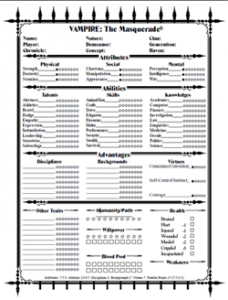The design of a role-playing game’s character sheet seems to come at the end of the design process, in my experience. For most games, this means that the design of the character sheet is influenced by the design of the 200 or so pages that were designed before it. Other game’s character sheets, such as the one I recently did for Space: 1889, are also influenced by other character sheets from the game line. In the case of Space: 1889, not only was the sheet supposed to be a sheet for that specific game, but the sheet had to function as a Savage Worlds character sheet, which meant there were certain things that had to be on the final product. The result works and I think it’s a good sheet while working in the constraints brought about by the overall game line (as the designer, I may be biased).
Continue reading →
On Character Sheets
 The job of a graphic designer is not to make things look pretty; it is to communicate information. Today, we were talking about character sheets in roleplaying games on Twitter, specifically the Vampire: the Masquerade sheet. Daniel writes that his biggest issue with that sheet “is the lack of emphasis on the core theme of Humanity vs Beastâ€. A look at the sheet he was talking about not only illustrates his issue, but also illustrates a fatal flaw in the character sheet: there is no hierarchy of information. Nothing on the sheet tells you what is important for the game: everything on the sheet has the same weight or visual density and becomes a wall of nothing. (The wall of nothing would be especially troublesome when that sheet has information added to it by the player.)
The job of a graphic designer is not to make things look pretty; it is to communicate information. Today, we were talking about character sheets in roleplaying games on Twitter, specifically the Vampire: the Masquerade sheet. Daniel writes that his biggest issue with that sheet “is the lack of emphasis on the core theme of Humanity vs Beastâ€. A look at the sheet he was talking about not only illustrates his issue, but also illustrates a fatal flaw in the character sheet: there is no hierarchy of information. Nothing on the sheet tells you what is important for the game: everything on the sheet has the same weight or visual density and becomes a wall of nothing. (The wall of nothing would be especially troublesome when that sheet has information added to it by the player.)
Continue reading →
Nightfall!
Crazy good news to start the year off right–I arrived home this afternoon to find out that one of the games I worked on this summer has been officially announced. AEG’s Nightfall, a deck-construction game about vampires and other undead nasties, is coming out in early 2011! (And, if you head over to the Nightfall website, you can win one of 100 copies of the game!)
Continue reading →